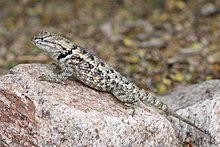Barbed Guinea
| Barbed Guinea | ||||||||||||
|---|---|---|---|---|---|---|---|---|---|---|---|---|

Sceloporus cyanogenys , male |
||||||||||||
| Systematics | ||||||||||||
|
||||||||||||
| Scientific name | ||||||||||||
| Sceloporus | ||||||||||||
| Wiegmann , 1828 |
The spiny guinea ( Sceloporus ) are the species-richest genus of the family Phrynosomatidae and occur in North and Central America.
distribution and habitat
Barbed guans are mainly native to Central and North America. Representatives of the genus Sceloporus inhabit different habitats and are mainly found on rocky terrain, but also in dry deserts, scrubland and relatively moist pine and cloud forests at an altitude of up to 3800 meters.
Way of life
The animals are predominantly terrestrial, but some species (such as Sceloporus malachiticus ) also live on trees and branches or in homes they dug themselves (such as Sceloporus magister ). The animals are ovoviviparous and primarily eat insects of all kinds, especially ants, beetles, flies, grasshoppers, crickets and the like. Also arachnids and smaller lizards, more rarely fruits and flowers are on their menu. When danger threatens, the iguanas quickly flee into crevices or rodent burrows or seek cover under bushes and tree stumps.
As with most other iguanas, the barbed iguanas hibernate - depending on the climate. The mating season extends from spring to summer. During this time, one or more clutches of up to 20 eggs are produced. To do this, the female digs a hollow in loose soil, which is closed again after the eggs have been laid.
features
Barbed guans have a pronounced sexual dimorphism . The males are generally more strongly colored; the colorations are particularly noticeable during the mating season. Females, on the other hand, are usually more simply colored. Barbed guans can reach a length of up to 30 cm. Their keeled, overlapping scales are characteristic. The head is broad and flattened, the limbs short and strong. The back legs are longer than the front legs and end in long toes with claws, which makes them good climbers.
Systematics

The genus Sceloporus comprises over 90 species, which in turn are divided into 21 groups.
The following is a list of known Sceloporus species:
- Sceloporus acanthinus
- Sceloporus adleri
- Sceloporus aeneus
- Sceloporus anahuacus
- Sceloporus angustus
- Sceloporus arenicolus
- Sceloporus asper
- Sceloporus aureolus
- Sceloporus becki
- Sceloporus bicanthalis
- Sceloporus bulleri
- Sceloporus caeruleus
- Sceloporus carinatus
- Sceloporus cautus
- Sceloporus chaneyi
- Sceloporus chrysostictus
- Sceloporus clarkii
- Sceloporus couchii
- Sceloporus consobrinus
- Sceloporus couchii
- Sceloporus cowlesi
- Sceloporus cozumelae
- Sceloporus cryptus
- Sceloporus cupreus
- Sceloporus cyanogenys
- Sceloporus printer colini
- Sceloporus dugesii
- Sceloporus edwardtaylori
- Sceloporus exsul
- Sceloporus formosus
- Sceloporus gadovae
- Sceloporus goldmani
- Sceloporus graciosus
- Sceloporus grammicus
- Sceloporus grandaevus
- Sceloporus heterolepis
- Sceloporus horridus
- Sceloporus hunsakeri
- Sceloporus insignis
- Sceloporus jalapae
- Sceloporus jarrovii
- Sceloporus lemosespinali
- Sceloporus licki
- Sceloporus lineatulus
- Sceloporus lunae
- Sceloporus lundelli
- Sceloporus macdougalli
- Sceloporus maculosus
- Sceloporus magister
- Sceloporus malachiticus
- Sceloporus megalepidurus
- Sceloporus melanorhinus
- Sceloporus merriami
- Sceloporus monserratensis
- Sceloporus mucronatus
- Sceloporus nelsoni
- Sceloporus occidentalis
- Sceloporus ochoterenae
- Sceloporus olivaceus
- Sceloporus omiltemanus
- Sceloporus orcutti
- Sceloporus ornatus
- Sceloporus palaciosi
- Sceloporus parvus
- Sceloporus poinsettii
- Sceloporus pyrocephalus
- Sceloporus rufidorsum
- Sceloporus salvini
- Sceloporus samcolemani
- Sceloporus scalaris
- Sceloporus serrifer
- Sceloporus siniferus
- Sceloporus slevini
- Sceloporus smaragdinus
- Sceloporus smithi
- Sceloporus spinosus
- Sceloporus squamosus
- Sceloporus stejnegeri
- Sceloporus subniger
- Sceloporus subpictus
- Sceloporus taeniocnemis
- Sceloporus tanneri
- Sceloporus teapensis
- Sceloporus torquatus
- Sceloporus tristichus
- Sceloporus undulatus
- Sceloporus utiformis
- Sceloporus vandenburgianus
- Sceloporus variabilis
- Sceloporus virgatus
- Sceloporus woodi
- Sceloporus zosteromus
literature
- Heiko Werning : Barbed Guane. Natur und Tier-Verlag, Münster 2002, ISBN 3-931587-13-4 .

